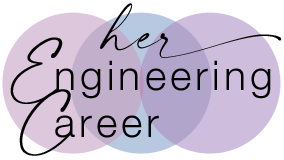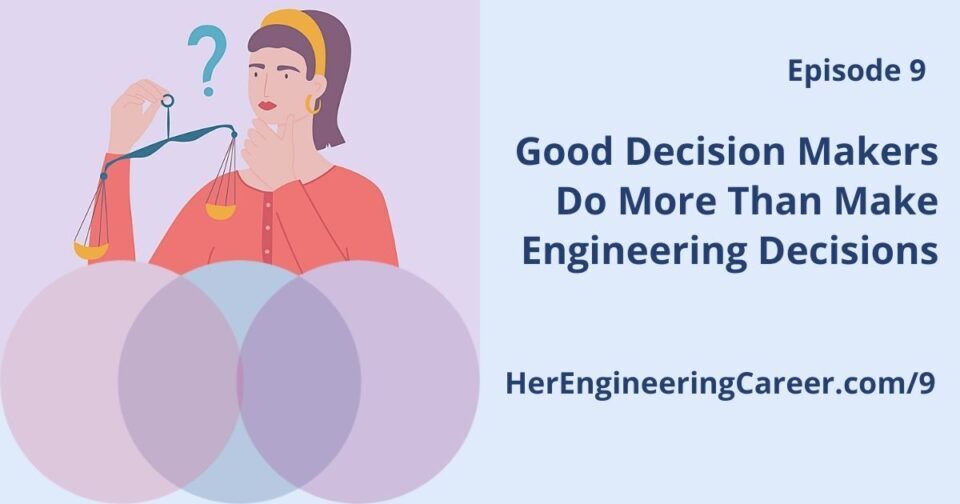Show Notes
As engineers, we are pretty well trained in decision-making. What we do primarily is solve problems, and that’s what problem-solving is when you think about it: decision making at various levels of complexity.
The design process is basically iterative decision making. A systems flowchart is a set of instructions connected by decision nodes. We use experimentation and the scientific method as structured ways of guiding decisions.
We’ve learned the cognitive approaches to determining a course of action. We’ve studied rational approaches to choosing an alternative, approaches that are designed to minimize resources and maximize benefits.
This is much of what engineering is all about.
In this podcast, though, I’m talking about decision making for engineers, but not engineering decision making. I’m referring to the skill of decision making as it applies to moving up in your engineering career and becoming a leader.
- This kind of decision making is not merely based on numbers and data, but also on people, culture, innovation, idea management, and corporate learning.
- This kind of decision making uses more naturalistic approaches, such as influence from personal beliefs and experiences, the meanings of options, the role of emotions.
- And this kind of decision making is probably causing you some angst because it is a skill that you need to have to move up in your career and it is not the same as what you learned in engineering school.
As you know the higher you move up in leadership, the more impactful decision making becomes. There is more to take into account and more at stake.
And maybe from where you’re standing now, it looks scary. It’s hard to think of yourself in those decision-making shoes.
But I don’t want you to think about it this way. Most people are not naturals when it comes to decision making. Just like you and me, they needed to learn the skill and practice it.
The basis of this skill is a decision making process. This is probably something you already know. Here’s a common example:
Step 1: Identify what the decision is. Step 2: Gather the relevant information. Step 3: Identify the possible alternatives. Step 4: Weigh all the evidence. Step 5: Choose among the alternatives. Step 6: Take action. Step 7: Assess your decision and its consequences.
The time and effort you’ll spend on the decision process, of course, is proportional to the impact of the decision.
For higher-level leadership decisions, this process is not as easy and straightforward as it may sound. So I’m adding 3 additional lessons that you can use to build your decision making skills.
3 Lessons Women Engineers Can Use to Build Their Decision Making Skills
- You will not have all the input and data you need to make a decision. You’ll have to take some risk and make the call without having all the questions answered and all the holes filled in.
You’ll rely on your intuition and experience and the guidance and recommendations you receive from others. You’ll decide based on input and analysis. You won’t have all that you need, but you’ll make the best decision you can.
By the same token, assume that not everyone will agree, and know that you cannot please everyone.
- There’s no right or wrong answer. If the decision is a yes-or-no question, then the answer is usually obvious and the outcome easily measured. But most decisions are not yes-or-no questions.
Leaders don’t figure out the right answer, because there is no right or wrong. They just decide on the best option.
By the way, what you think is the best option may be different from what others think is best. And that’s okay, because we want you to follow your own intuition and truth as a leader.
- Managing the outcome is at least as important as making the decision itself. Once you’ve made the decision, you’ll not only inform the team, but also help them change directions, face new challenges, and generate better outcomes as a result.
People move quickly away from what the actual decision was to how the leader manages it and what happens as a result.
For more impactful decisions, there’s always a plan that goes along with it. Here’s my decision and here’s how we’re going to carry it out. That’s what people focus on.
You might make a decision that turns out to be suboptimal or not well-accepted. How you handle that says a lot about you as a leader.
Leadership Characteristics for Women Engineers that Enhance Decision-Making Skills
Here are some characteristics of good decision makers that you can incorporate as you work to build your decision-making skills:
- Due diligence in the decision-making process.
- Vulnerability and risk-taking in choosing what you think is best.
- Transparency in gathering input and weighing evidence.
- Clarity in communicating the decision and its consequences.
- Follow-through with implementation.
- Willingness to learn from your mistakes.
You have what it takes to make good decisions. You can be a strong leader with good decision-making skills. Don’t let the fear of decision making keep you from stretching into your leadership roles.
If you’re thinking about enhancing your career by learning more about your leadership and decision-making potential, how to get ahead and have more impact in the engineering community, I’d love to chat with you about that. You can tell me a little about yourself and set up a Discovery Call here.
Recap: We began today’s podcast by distinguishing between engineering decision making and decision making for leadership and advancement.
We reviewed a common process for decision making and enhanced that with 3 additional lessons to help women engineers build their decision making skills. And finally we highlighted some characteristics of good decision makers.
Coming up on Her Engineering Career Podcast we’ll spend a couple episodes on time and workload management, including skills that will help you prioritize, optimize, and stay on the path to meet your career goals. Join me next time for Episode 10.
References: Tufts University, Electrical and Computer Engineering Design Handbook Jonassen, D.H. Designing for decision making. Education Tech Research Dev 60, 341–359 (2012) UMass Dartmouth, Decision-making process

